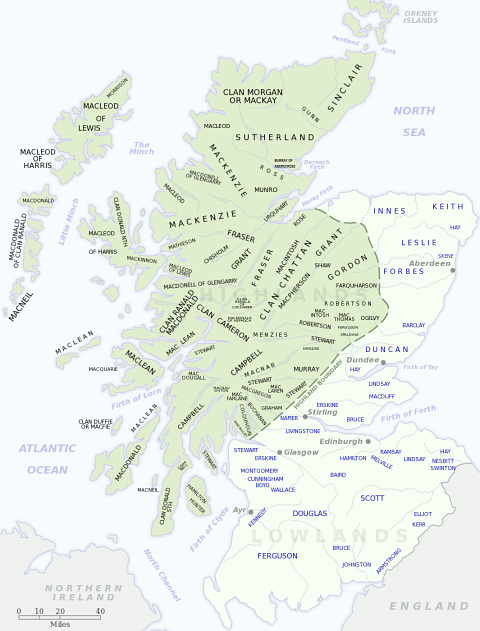
Motto: Ne oublie (Forget Not)
Historic Seat: Mugdock Castle
District: Stirlingshire
Associated Surnames: Airth, Bonar, Bontein, Bontine, Buntain, Bunten, Haddon, Howe, Howie, MacGilvernock, MacGrime
Associated Tartans:
Early Graham Genealogy and History:
(Excerpt from "The Scottish Clans and Their Tartans", James Grant, 1906)
Few families, says Sir Walter Scott, can boast of a more historical renown than that of Graham. So much obscurity and fable involve the origin thereof, that even Sir Robert Douglas repeats the old story, that the Grahams are descended from a famous warrior who breached the Roman wall in 420, and won it the name of Graham's Dyke in the time of Fergus II.
William of Graham is one of the witnesses of David I, Holyrood Charter, circa 1143-47 - the first authentic appearance of the name. He obtained the lands of Abercorn and Dalkeith. His grandson and representative, David Graham, obtained from William the Lion, before 1214, certain lands near Montrose. David's son, of the same name, acquired, under the succeeding monarch, by exchange of land belonging to him in Galloway, from Patrick, Earl of Dunbar, the lands of Dundaff and Strathearn, and from the Earl of Lennox those of Strathblen and Mugdock. He was one of the guarantees of a treaty with Henry III in 1244. His son, Sir David of Dundaff, married a daughter of the Earl of Strathearn, by whom he had three sons - Sir Patrick, Sir John, and Sir David. The second was the "Richt Hand" of Wallace, in whose arms he died of his wounds after the battle of Falkirk. Sir Patrick had previously fallen at Dunbar1, and when dying gave his sword to his son, and made him swear upon the blade that while he lived he would fight for Scotland. That sword is now in the possession of the Duke of Montrose.
His grandson and representive, Sir David, in a royal charter witnessed by him in 1360, is styled of Old Montrose. In that year his son Patrick, with many men of rank appeared on the Forth, near Stirling, to adjust a bloody feud between the Drummonds and Menteiths. By his eldest son of a second marriage, Sir Patrick Graham of Elieston, he was the ancestor of the Earls of Menteith of the name of Graham.
His son, Sir William, Dominum de Graham et Kincardine, obtained from Robert, Duke of Albany, a charter containing an entail of Old Montrose. Patrick, his grandson, was one of the Lords of the Regency after the murder of James I, and was created Lord Graham by James II about 1445. The third Lord was created Earl of Montrose by James IV in 1504, and fell by the side of the latter at Flodden2, 1513.
His great-grandson, John, third Earl (whose father, Lord Graham, had fallen at Pinkie) was Lord High Chancellor, and in 1598 Lord High Treasurer of the Kingdom.
James, fifth Earl and first Marquis of Montrose, born in 1612, by the splendour of his valour in the Royal cause, was, "The Great Montrose." He perished on the scaffold in 1650; but for the memory of his services to the Crown, James, fourth Marquis of Montrose, was raised to a Dukedom by Queen Anne in 1707. We regret to add that he sold his Union vote for £1000.
Eighteen landed gentlemen, all the surname of Graham, officiated at the state funeral of the Great Marquis at Edinburgh in 1661.
The immediate ancestor of the Claverhouse Grahams was Sir William of Kincardine, who lived in the time of Robert III. David, brother of the first Viscount of Dundee, followed King James to France, and died in 1700.
The Graham of Barco and Gartmore were made Baronets respectively in 1625 and 1665. The Border Graemes, who chiefly inhabited the Debatable Land, claimed their descent from Malise, Earl of Strathearn, otherwise Menteith.
James, the first Duke, died in 1742, and was succeeded by his son William, second Duke, great-grandfather of Douglas, fifth and present Duke of Montrose. Since the twelfth century the succession in this family has been from father to son, the chiefship never going further astray than a brother succeeding a brother, or a grandson his grandfather; and since the sixteenth century all the heads of the family (except the present) have married the daughters of peers.
(End excerpt)
Next page: Clan Grant
Footnotes:
1 The Battle of Dunbar (1296): The battle of Dunbar was fought on 27 April 1296 near Dunbar, Scotland, and was a decisive English victory over Scotland in the the First War of Scottish Independence. Read more about the Battle of Dunbar (1296) at Wikipedia.
2 The Battle of Flodden (1513): The Battle of Flodden Field was fought on 9 September 1513, in Northumberland England between an army of Scots under King James IV and an English army commanded by the Earl of Surrey. Read more about the Battle of Flodden at Wikipedia.

Distribution of Scottish clans and families
View larger map at Wikimedia Commons

Browse the Clan Graham Tartan Collection with home decor, personal accessories, crafting, paper products, and more.

Browse the Clan Graham Dress Tartan Collection with clothing, home decor, accessories, electronics cases, and more.

Clan Graham Postcard: Digitally cleaned and enhanced vintage illustration with tartan border.